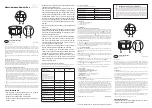
Rockwell Automation Publication 7000L-UM301F-EN-P - March 2020
199
Commissioning
Chapter 4
Example:
The resistance across the anode-to-cathode of a 1500 amp device may be 57 kΩ
even though the sharing resistor is 80 kΩ.
A failure of an SGCT can be detected by measuring a lower than normal
resistance value; one device in the converter may read 15 kΩ whereas the rest of
the devices in the converter measured close to 60 kΩ. This indicates a partially
shorted device. A fully shorted device will read closer to 0 Ω and will be quickly
identified. If the SGCT is found to be out of tolerance, refer to
Definition and Maintenance on page 265 (Chapter 5)
for detailed instructions
on how to replace the SGCT assembly.
Damage to a sharing resistor is easily detected if the SGCT is replaced and the
anode-to-cathode resistance remains abnormal. If the resistor is found to be out
of tolerance, refer to
Component Definition and Maintenance on page 265
for detailed instructions on how to replace the snubber/sharing
resistor assembly.
Snubber Resistance (SGCT Device)
Access to the snubber resistor is not required to test the resistance. The snubber
circuit test point is located within the PowerCage under the chill blocks. For each
device, there is one test point. To verify the resistance, measure the resistance
between the test point and the chill block directly above the test point.
Figure 183 - Snubber Resistor Test
Refer to
to determine the appropriate snubber resistance value for the
SGCT used in either the AFE Rectifier or the inverter.
If the resistor is found to be out of tolerance, refer to
Maintenance on page 265 (Chapter 5)
for detailed instructions on how to
replace the snubber resistor assembly.
Measure resistance
between chill block
and test point.
Snubber Test Point
Measure resistance
between chill block
and test point.
Snubber Test Point
















































